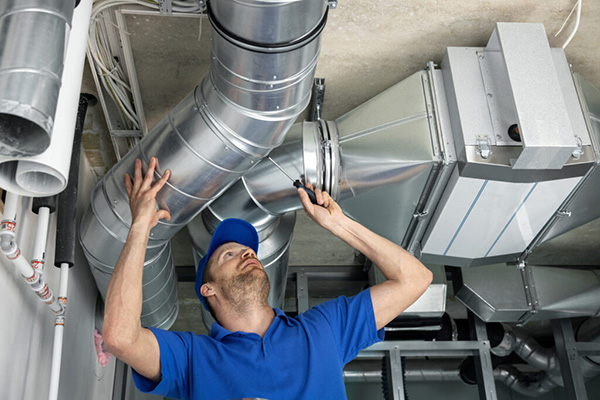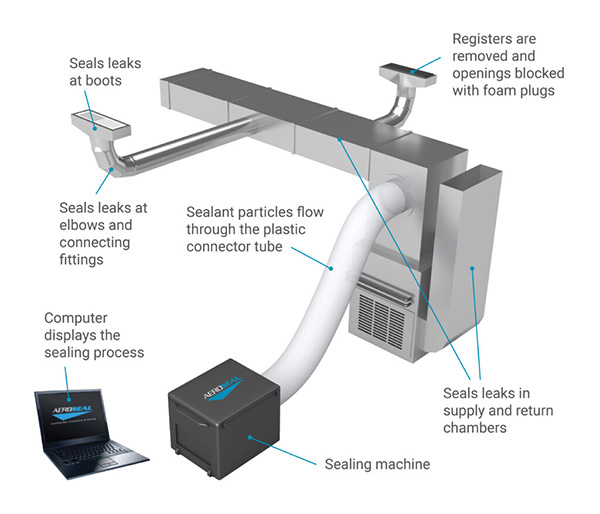Ductwork Misconceptions Debunked

Why are there ductwork misconceptions?
Ductwork isn’t the most-talked-about topic on the block. There are many ductwork misconceptions that are keeping ducts from receiving the spotlight that they should. All ducts leak air. Every one. Many people do not know this, and while many HVAC professionals do, they mistakenly believe that it’s not a big problem. Now let’s poke some holes in those leaky lies.
I have a new home/building. So my ducts shouldn’t leak?
This seems like it should be the case. All the ductwork should be in pristine condition, so there shouldn’t be any air escaping, right? Well, the thing is, any time you have a metal-on-metal connection, there’s going to be some leakage. With flex duct, which has flexible inner core and is easily bendable, you have a little more air tightness, but any time you have two pieces of sheet metal and join them together, there will be leakage. So how could construction crews get away with installing ductwork that loses a significant portion of your conditioned air?
Well, all builders need to do is create a home that passes a certain air tightness code. However just reaching that code does not mean that the duct systems are working properly, and that they are working in favor of the homeowner by protecting air quality, providing comfort, and saving energy. In most cases, builders are going to reach that code by doing the bare minimum, leaving your ducts unprotected and causing problems in your house.


I can seal any duct leakage with tape or Mastic.
Many contractors mistakenly believe duct tape is sufficient for sealing, but it often fails under stress, especially in unconditioned spaces. Over time, whether it’s months or years, it will inevitably come loose, exposing your ducts to air leaks. Using mastic, a type of sticky sealant commonly used in construction and HVAC applications, is another option to manually seal ducts. However, sealing with Mastic isn’t a pleasant task, leading to less than perfect results. Imagine carrying a big bucket of sealant with the consistency of mashed potatoes. Then, you’re told to carry that heavy bucket into crawl spaces and attics trying to look for leaks to coat with a brush. It’s nothing against the contractors, it’s just a challenging job. Without proper testing, they may not even realize the extent of their work. Although newer codes are improving, they’re not flawless everywhere yet.
Duct sealing isn’t worth paying for
By not sealing ducts, you are opening your house to a host of problems. Duct leakage can exacerbate humidity issues by introducing moisture from the outside environment into the home. In regions with high outdoor humidity levels, even a small amount of duct leakage can significantly increase indoor humidity levels. This excess moisture can contribute to a range of problems including mold growth, musty odors, and discomfort for occupants.
In addition, modern HVAC systems are not designed to handle the extra moisture introduced by duct leakage. While air conditioning naturally removes some humidity from the air as it cools, the added moisture from duct leakage can overwhelm the system’s capacity to dehumidify effectively. This can lead to an indoor environment that feels sticky and uncomfortable, even when the temperature is adequately controlled.
Sealing air ducts is essential for balanced comfort throughout the home. For example, basements tend to be cooler than the rest of the house due to their location and lack of insulation. If ducts leading to the basement are leaking air, the conditioned air intended for other parts of the house may end up escaping into the basement exacerbating the issue. By sealing ducts, homeowners ensure consistent airflow, maintaining comfortable temperatures in every room and improving overall living conditions.
Sealing air ducts is also crucial for indoor air quality and allergy control. Duct leakage introduces dust and allergens into living spaces, exacerbating allergies in adults and leading to respiratory issues. By sealing ducts, homeowners can prevent the infiltration of pollutants, creating a healthier indoor environment and reducing allergy symptoms for occupants.
Conclusion
All these ductwork misconceptions cause people to believe that unless they see any major holes, that their ductwork is fine as-is. The truth is, by ignoring duct sealing, you’re offering up your home to a multitude of problems caused by leaky ducts.
So, what if there were a way to seal all the ductwork, even the unexposed, from a single injection point? That’s where Aeroseal comes in. Aeroseal is the only machine air sealing company that can seal leaks and take air leakage down to nearly zero in one simple process. Even the leaks you can’t see. Aeroseal’s non-toxic, water-based sealant efficiently seals air leaks in both ducts and the building envelope itself, ensuring that your air goes where you need it and not where you don’t.
Click here to learn how Aeroseal works














